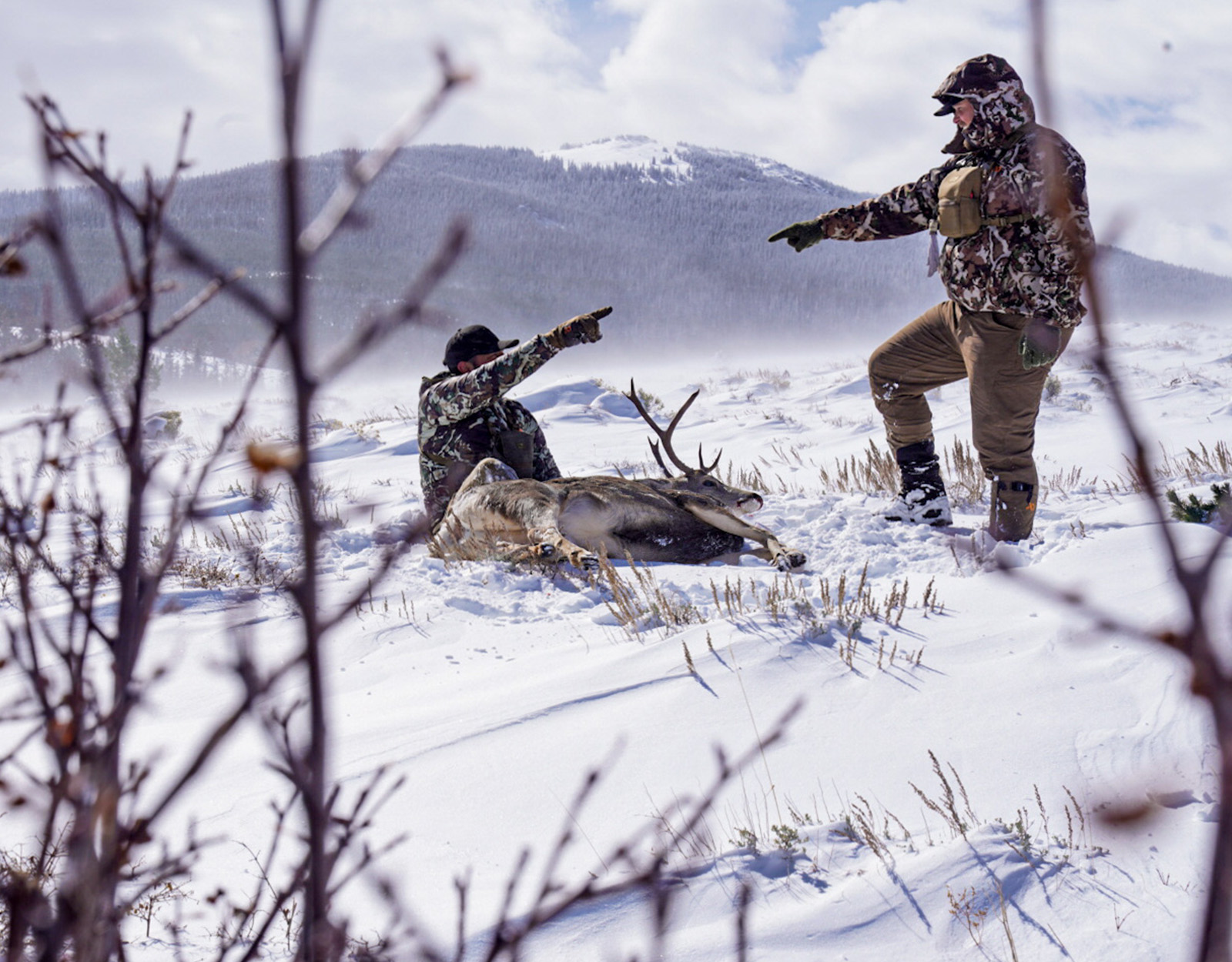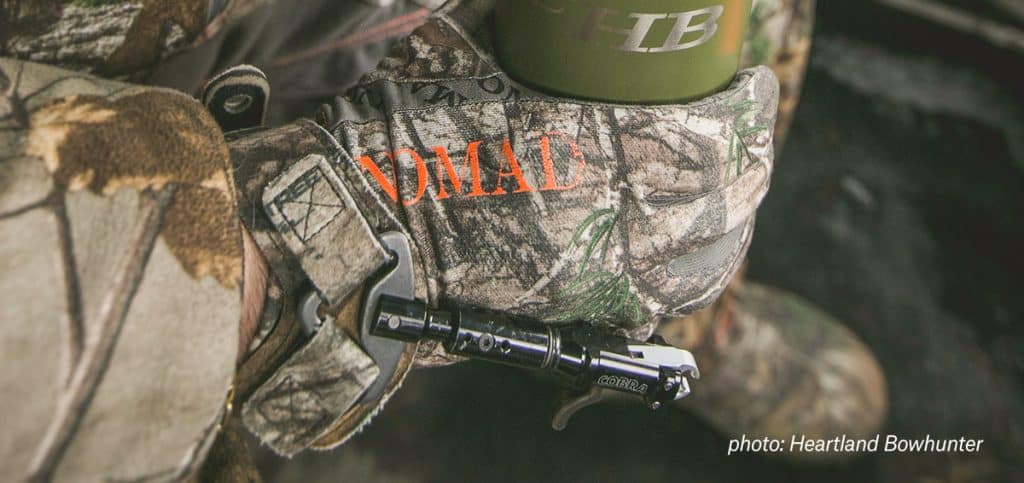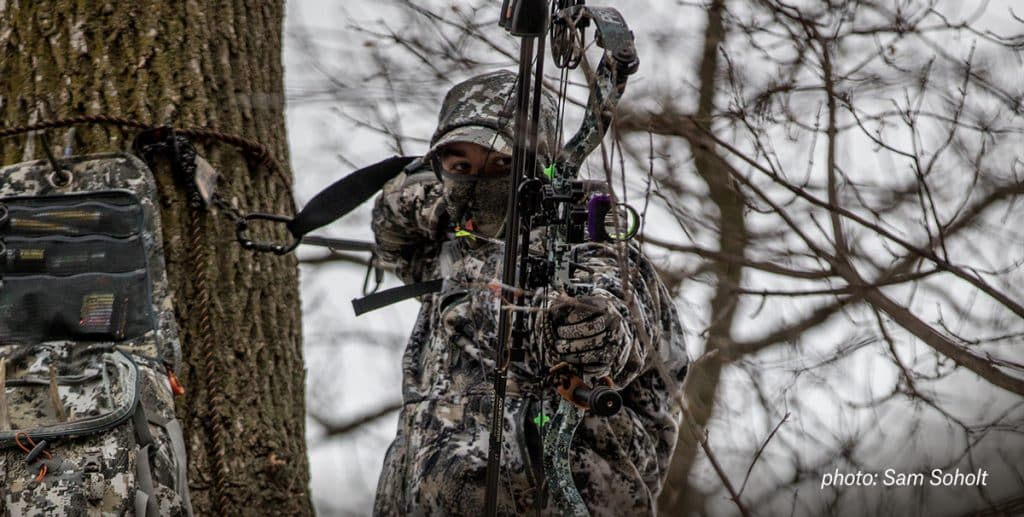If you know how to stay warm while hunting you’ll be able to hunt longer, more comfortably, and increase your chance of filling your tag. Hunting experts from all over have their favorite tips and tricks for how to stay warm hunting in cold weather, and they have shared a few of them with us below. Whether you’re covering a lot of ground in western high country, glassing for hours on an exposed hillside, or sitting still in a tree stand, you’ll be able to use this knowledge to master cold weather hunting.
Stay Dry, Stay Warm When Hunting
If you can keep dry as possible you’ll be much warmer in the field. Your body loses heat in several related ways. Most of your body’s heat loss is due to heat radiated from unprotected surfaces of your body. Heat loss also happens through direct contact with something cold – cold water or cold air – because your stored heat gets conducted away from your body.
Heat loss happens faster when exposed to cold water than cold air because its thermal conductivity is 24 times greater than that of air. This is why wearing wet clothes (or falling into cold water) can lead to hypothermia quicker than just being out in a cold breeze.
Additionally, being exposed to cold winds can zap your body heat. If you’re familiar with the common term, “wind chill,” it’s because it’s a real factor in how cold we feel in windy conditions. Wind blowing against exposed skin will actually blow away the thin layer of warm air at the surface of our skin, making us colder.
Our first line of defense in staying warm when hunting is to stay dry. Here are the best ways to do that:
- Avoid Sweating. It sounds like a bold idea; hunting is a physical activity, but doing as much as you can do to avoid excessive sweating before you plan to sit and glass or sit in your treestand will certainly save you from getting chilled. During intense exercise, the body can lose up to 85% of its heat through sweating. Dress lighter when your hunt starts on the move and plan to add layers when you get to your stopping point. Besides, stopping to shed layers only adds another opportunity to get busted by a savvy deer or elk.
- Don’t wear cotton. Cotton does kill. When cotton gets wet, it stops insulating your body because the fabric’s air pockets fill up with water. When you’re hiking you sweat, and any cotton clothing next to your skin will absorb your sweat like a sponge.
- “Maintain the layering philosophy of base/insulation/shell.” – DIY Sportsman’s Garrett Prahl
Start with a good base layer – Merino wool is the top choice here. A quality layer next to your skin will allow sweat to wick away from your body. A mid-layer is what will do the most for retaining your body heat but still allow for some moisture-wicking. Fleece is a top choice, with many opting for a layer with a hood. The outer shell serves as a barrier to prevent outside moisture (and wind) from coming in, but it also prevents perspiration from getting out, so plan on using your outer shell when you’re sitting still and less when you’re actively hiking.

Warm Hands, Warm Feet When Hunting
While wearing a warm hat has always been good motherly advice, scientists are now debunking the myth that people lose as much as 80 percent of their body heat through their heads. Part of this now “myth” can be traced back to a 1970 U.S. Army Field Manual (from a study done in the 1950s) that claimed “40 to 45 percent of body heat” is lost from the head. Over the years, that percentage grew. In 2008, the British Medical Journal published a study that showed we only lose between seven and 10 percent of our body heat through our heads. Our face and our head, however, are more sensitive to changes in temperature than other parts of the body, so it can “feel cold” when we’re not wearing a warm hat.
When it comes to hands and feet, we really are faced with a challenge to stay warm. One of the ways our bodies respond to cold temperatures is to constrict blood vessels in the arms and legs, reducing blood flow to our extremities. The body does this to protect the brain and vital organs, but it leaves the fingers and toes susceptible to frostbite. Without as much blood flowing through our hands and feet, it becomes important to protect them with clothing or another source of heat (think campfire).
“Hands and feet will get cold first and that will cause your whole body to cool off, so good boots and wool socks are a must, as well as warm gloves or mittens.” – Big Woods Bucks’ Hal Blood
Mittens over gloves – that’s a trick for keeping your hands warm while hunting, or at least when you don’t need quick access to your trigger finger. The reason mittens work better than gloves is because your fingers generate more heat collectively when they are not separated from each other. Mittens are generally fine when you’re walking or hiking, and they can provide enough dexterity to operate a spotting scope or hold a pair of binoculars.
“Dry feet are warm feet. Antiperspirant foot lotion and uninsulated boots can help prevent foot sweat.” – DIY Sportsman’s Garrett Prahl
If you’re hiking to your hunting spot, wear the most breathable wool socks you have, and then plan on changing them when you’re about to sit. Medium-weight Smartwool socks seem to be a consistent choice among the onX staff hunters.
Waterproof boots are a must. Depending on your terrain and exact weather conditions, you may opt to wear uninsulated boots or leather boots. If you need extra warmth, hunting boots with at least 200 grams of insulation can be a game-changer. If you know you’ll be trudging through snow, invest in a quality pair of gaiters to keep even trace amounts of snow from getting into your boots.

How To Stay Warm in a Tree Stand or While Glassing
Keeping warm while sitting still for long periods of time is especially challenging. Too often hunters cut their hunts short because they’re shivering and can’t get back the body heat they’ve already lost. To help hunters stay warm while staying put, we’ve compiled some excellent tips from our onX Ambassador and staff.
“Sit on a foam pad. It will make your bottom noticeably toasty. I carry a 14”x14” piece of recycled foam insulation with me on every hunt and use it often.” – onX Marketing Manager Andy M.
“Disposable hand and boot warmers are a big help.” – Big Woods Bucks’ Hal Blood
“I pack my outer layers in and climb to my tree stand in my base layers. I can then let some sweat evaporate more readily before putting my outer layers on.” – onX GIS Analyst Noah H.
“Pull-over boot covers for in the tree stand! Muff too!” – onX Marketing Specialist Jared L.
“My husband bought me a rechargeable hand warmer. That’s been a game-changer!” – onX Customer Success Tech Jen M.
“Buddy heater in a ground or box blind!” – onX Business Dev. Manager Ben B.

Other Things You Can Do to Keep Warm
Beyond having reliable gear, the right amount of layers, and not sweating, there are a few other things you can do that will help you generate or retain warmth while on your hunt.
Eat Right – Staying hydrated and eating right includes consuming calorie-rich foods. You’re aiming to avoid spikes in blood sugar, which will make you cold. Proteins, good fats, and complex carbohydrates will be the winners here. Single-use nut butters are popular with onX staff because they can be added to oatmeal or eaten directly. Packing a backpacking stove means you can prepare hot soups, coffee, or even small meals (plus get a little warmth from the stove itself).
With hydration, you’ll want to find the right balance. Too much water and you’ll risk an imbalance of electrolytes and using body energy to keep a full bladder warm. Of course, too little water and you’ll experience dehydration and have lower blood volume and poor circulation, making you feel cold. The Institute of Medicine recommends a healthy adult drink 78–100 ounces of fluids per day, on average.
Stretch and Flex – Even 15 minutes of sitting still and your body’s metabolism starts to slow down and your blood flow slows. A good stretch and flexing any muscles you can will generate some body heat. Plus, you’ll have that walk back to your truck after the hunt, and when it’s cold your muscles tend to tighten, making them more prone to cramps and injury.
Build a Fire – Perhaps a last resort, but a campfire can save you from calling a hunt altogether and driving home. Burn it as clean as you can, and always make sure it’s dead out before you leave the area.
~~~
Staying warm while hunting is part planning and part managing your hunt. It’s easier to prevent getting cold than it is to get warm after you’re chilled. Staying dry is rule number one, and wearing layers is nearly equal to that. And remember, it’s okay to get creative, move around a little, bring that extra layer, or hunker down to get out of the wind for a while if it means your hunting trip gets to last a little longer.